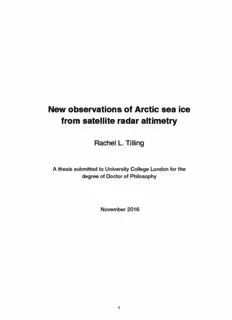
New observations of Arctic sea ice from satellite radar altimetry PDF
Preview New observations of Arctic sea ice from satellite radar altimetry
New observations of Arctic sea ice from satellite radar altimetry Rachel L. Tilling A thesis submitted to University College London for the degree of Doctor of Philosophy November 2016 1 2 I, Rachel Tilling, confirm that the work presented in this thesis is my own. Where information has been derived from other sources, I confirm that this has been indicated in the work. 3 4 Abstract Satellite observations of Arctic sea ice have observed a decline in extent for all months since 1979. The decline is coincident with abrupt global and Arctic warming over the last 30 years. Over this 30-year period the mean Arctic temperature has increased at almost twice the global average rate – a phenomena known as Arctic amplification. It is crucial to observe and understand changes in Arctic sea ice, as it is a major element of the Earth’s climate system. The sea ice cover acts to regulate solar absorption, ocean- atmosphere heat exchange, and freshwater and brine input into the Arctic Ocean and subpolar North Atlantic. The subsequent changes in the regional heat and freshwater budgets impact on patterns of atmospheric and oceanic circulation across the Arctic and at lower latitudes. These in turn impact on global weather patterns. To fully understand the global impacts of changes in the Arctic sea ice cover, long-term and accurate observations of the ice pack as a whole are required. However, it has previously been difficult to quantify trends in sea ice volume because detailed thickness observations have been lacking. The European Space Agency’s (ESA’s) CryoSat-2 satellite was launched in April 2010 and now provides unparalleled coverage of the Arctic Ocean up to 88°N. CryoSat-2 data have been used in this study to provide the first estimates of sea ice thickness and volume across the entire Northern Hemisphere. Using five years of CryoSat-2 measurements a 14% reduction in sea ice volume was observed between autumn 2010 and 2012, in keeping with the long-term decline in extent. However, 33% and 25% more ice were observed in autumn 2013 and 2014, respectively, relative to the 2010–2012 seasonal mean, which offset earlier losses. The increase was caused by the retention of thick sea ice northwest of Greenland during 2013 which, in turn, was associated with a 5% drop in the number of days on which melting occurred. This coincides with conditions more typical of the late 1990s. In contrast, springtime Arctic sea ice volume has remained stable. The sharp increase in sea ice volume after just one cool summer demonstrates the ability of Arctic sea ice to respond rapidly to a changing environment. Since April 2015, ESA have provided fast delivery CryoSat-2 data, which are based on preliminary orbits. The fast delivery data have been used to produce near real time (NRT) estimates of Arctic sea ice thickness and volume. This study finds that the NRT dataset provides a measurement within 14, 7 and 6 km of each location in the Arctic every 2, 14 and 28 days respectively. NRT sea ice thickness and volume data provide a new resource and opportunity for the developers of short-term sea ice forecast models. These models can provide information such as sea ice location, drift and thickness to operational users. Currently the utility of the NRT data for model and operational use is limited by a lack of availability in summer months. The expansion of sea ice thickness observations in to the melt season will form the basis of future work. 5 6 Acknowledgements First and foremost I wish to acknowledge my supervisors Professor Seymour Laxon and Dr Katharine Giles. Those who loved and worked with them have suffered an irreplaceable loss, and the loss of their expertise has been felt throughout the Polar research community. I’m grateful for the legacy they’ve left us, and will always strive to do it justice. I also wish to thank them, for seeing a potential in me that I didn’t believe I had, and encouraging me to run with it. Thanks to all who have supervised me along the way: Professor Duncan Wingham, Professor Chris Rapley, Dr Michel Tsamados and Professor Andy Shepherd (for his endless support and expert ‘constructive criticism’!) A special thank you to my friends Tom and Sam. We started our PhDs together and during that time they’ve made me laugh, made me grumpy, made me shot questionable spirits, made great playlists for long road trips across America (and Cornwall), and generally made me power on through. Thanks as well to CPOMers past and present: Isobel and Alek for being top class office mates, my colleague and friend Andy Ridout without whom none of this would have been possible, and Alan Muir for laughs at the pub and keeping calm when I deleted my IDL license… for the second time. I’d like to acknowledge those who have supported me from outside of UCL. Thanks to Dr Sinead Farrell for being the best ‘cheerleader’ going and to Dr Eero Rinne, who entrusted me with the barbecue on the deck of the R/V Aranda, somewhere in the Bay of Bothnia. Most of all, thanks to everyone involved with CryoVEx 2014. I’ll treasure the memories of evenings huddled in the mess tent on the Lincoln Sea, with Petter preparing the food and Marc supplying the laughs. Rest easy, Marc. Fieldwork will never quite be the same. The support from my friends and family has been unwavering. Mum, Dad, Ian, Max, Griff, Nat, Joc, Grace, Gemma, Liz, Chris, and Kevin the whippet – you are all awesome and I love you. Never stop being you! 7 8 For Seymour and Katharine 9 10
Description: